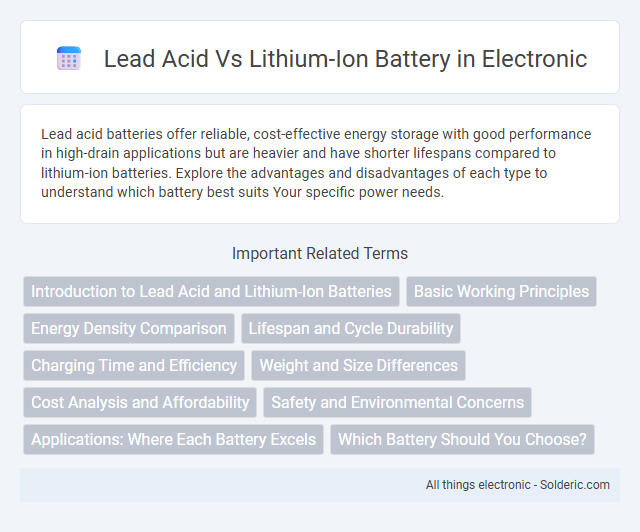Lead acid batteries offer reliable, cost-effective energy storage with good performance in high-drain applications but are heavier and have shorter lifespans compared to lithium-ion batteries. Explore the advantages and disadvantages of each type to understand which battery best suits Your specific power needs.
Comparison Table
| Feature | Lead Acid Battery | Lithium-Ion Battery |
|---|---|---|
| Energy Density | 30-50 Wh/kg | 150-250 Wh/kg |
| Cycle Life | 300-500 cycles | 1000-5000 cycles |
| Weight | Heavy | Lightweight |
| Cost | Lower initial cost | Higher initial cost |
| Maintenance | Requires regular maintenance | Low maintenance |
| Charging Time | Long (8-12 hours) | Short (1-4 hours) |
| Environmental Impact | Contains toxic lead, less eco-friendly | More eco-friendly, recyclable |
| Applications | Automotive, backup power, UPS | Mobile devices, EVs, renewable systems |
Introduction to Lead Acid and Lithium-Ion Batteries
Lead Acid batteries, known for their affordability and reliability, consist of lead plates submerged in sulfuric acid, making them ideal for automotive and backup power applications. Lithium-Ion batteries feature lightweight design and high energy density due to lithium compounds, offering longer cycle life and faster charging suitable for portable electronics and electric vehicles. Your choice between these battery types depends on factors like weight, energy needs, and budget constraints.
Basic Working Principles
Lead acid batteries operate through a chemical reaction between lead dioxide and sponge lead electrodes submerged in sulfuric acid, producing electrical energy via oxidation and reduction processes. Lithium-ion batteries rely on the movement of lithium ions between the anode and cathode through an electrolyte during charging and discharging cycles, enabling higher energy density and efficiency. Understanding these basic working principles helps you choose the right battery type based on performance needs and application.
Energy Density Comparison
Lithium-ion batteries offer significantly higher energy density compared to lead acid batteries, typically ranging from 150 to 250 Wh/kg versus lead acid's 30 to 50 Wh/kg. This means your devices can run longer and batteries weigh less, improving portability and efficiency in applications such as electric vehicles and renewable energy storage. The superior energy density of lithium-ion batteries makes them the preferred choice for high-performance energy solutions where space and weight are critical factors.
Lifespan and Cycle Durability
Lithium-ion batteries typically offer a lifespan of 8 to 10 years with cycle durability reaching up to 3,000 to 5,000 charge cycles, significantly outperforming lead acid batteries, which generally last 3 to 5 years with around 500 to 1,000 cycles. Lead acid batteries experience faster capacity degradation due to sulfation and thermal stress, limiting their long-term usability in high-demand applications. Your choice between these battery types should consider Lithium-ion's superior longevity and cycle durability for cost-effective, sustained performance.
Charging Time and Efficiency
Lead acid batteries generally have longer charging times, often requiring 8 to 12 hours to reach full capacity, whereas lithium-ion batteries can charge significantly faster, typically within 1 to 3 hours. Lithium-ion technology offers higher energy efficiency, with charge-discharge efficiency rates ranging from 90% to 95%, compared to lead acid's 70% to 80%. The faster charging and improved efficiency of lithium-ion batteries contribute to reduced energy losses and enhanced overall performance in various applications.
Weight and Size Differences
Lithium-ion batteries offer a significantly lighter weight and more compact size compared to traditional lead acid batteries, making them ideal for portable and space-sensitive applications. On average, lithium-ion batteries weigh up to 70% less and occupy about 40% less volume than lead acid counterparts with equivalent energy capacity. These weight and size reductions contribute to improved energy density, enhanced performance, and greater design flexibility in electric vehicles, renewable energy storage, and consumer electronics.
Cost Analysis and Affordability
Lead acid batteries generally have a lower upfront cost compared to lithium-ion batteries, making them more affordable for initial investments in applications such as automotive starters and stationary backup power. Lithium-ion batteries, while more expensive initially, offer longer lifespans and higher energy density, which translates to lower total cost of ownership over time due to fewer replacements and improved efficiency. The affordability of lead acid batteries suits budget-sensitive projects, but the overall cost-effectiveness of lithium-ion solutions is favorable for long-term and high-performance energy storage needs.
Safety and Environmental Concerns
Lead acid batteries pose significant environmental hazards due to toxic lead content and corrosive sulfuric acid, requiring careful disposal and recycling to prevent soil and water contamination. Lithium-ion batteries offer improved safety with lower risk of leakage and less toxic materials but can present fire hazards if damaged or improperly handled. You should prioritize proper usage and disposal protocols for both battery types to minimize environmental impact and ensure safety.
Applications: Where Each Battery Excels
Lead acid batteries excel in applications requiring high surge currents and cost-effective energy storage, such as automotive starters, backup power for uninterruptible power supplies (UPS), and renewable energy systems with moderate cycling demands. Lithium-ion batteries dominate in portable electronics, electric vehicles, and grid storage due to their high energy density, longer cycle life, and faster recharge rates. Industrial machinery, marine applications, and large-scale energy storage increasingly favor lithium-ion for weight reduction and extended operational lifespan.
Which Battery Should You Choose?
Lead acid batteries offer a cost-effective solution with reliable performance for applications like automotive starters and backup power, while lithium-ion batteries provide higher energy density, longer lifespan, and faster charging suitable for portable electronics and electric vehicles. Your choice depends on factors such as budget constraints, required energy capacity, weight considerations, and intended use duration. For heavy-duty, budget-friendly use, lead acid is ideal; for efficiency and longevity in modern devices, lithium-ion is the preferred option.
Lead Acid vs Lithium-Ion Battery Infographic

 solderic.com
solderic.com